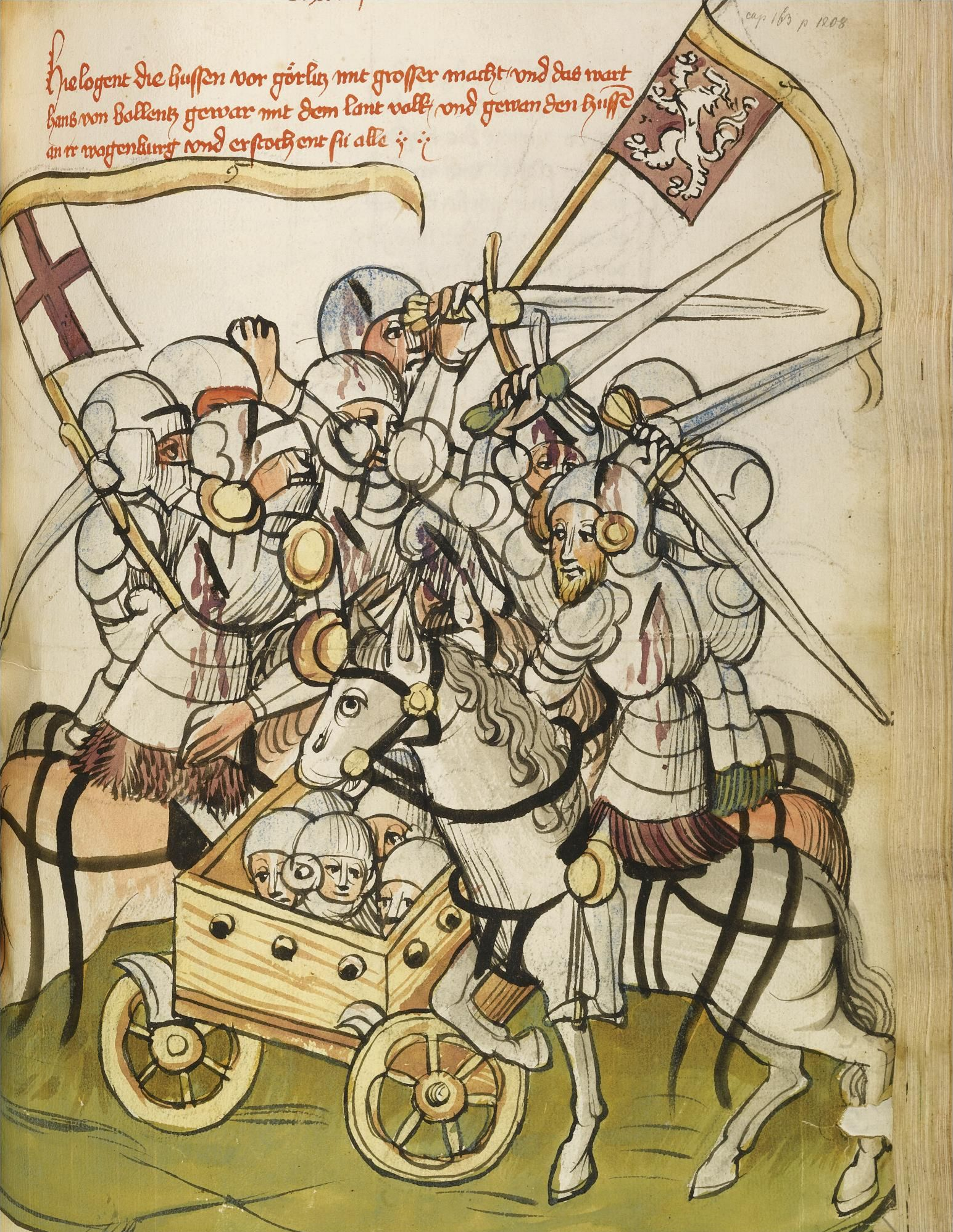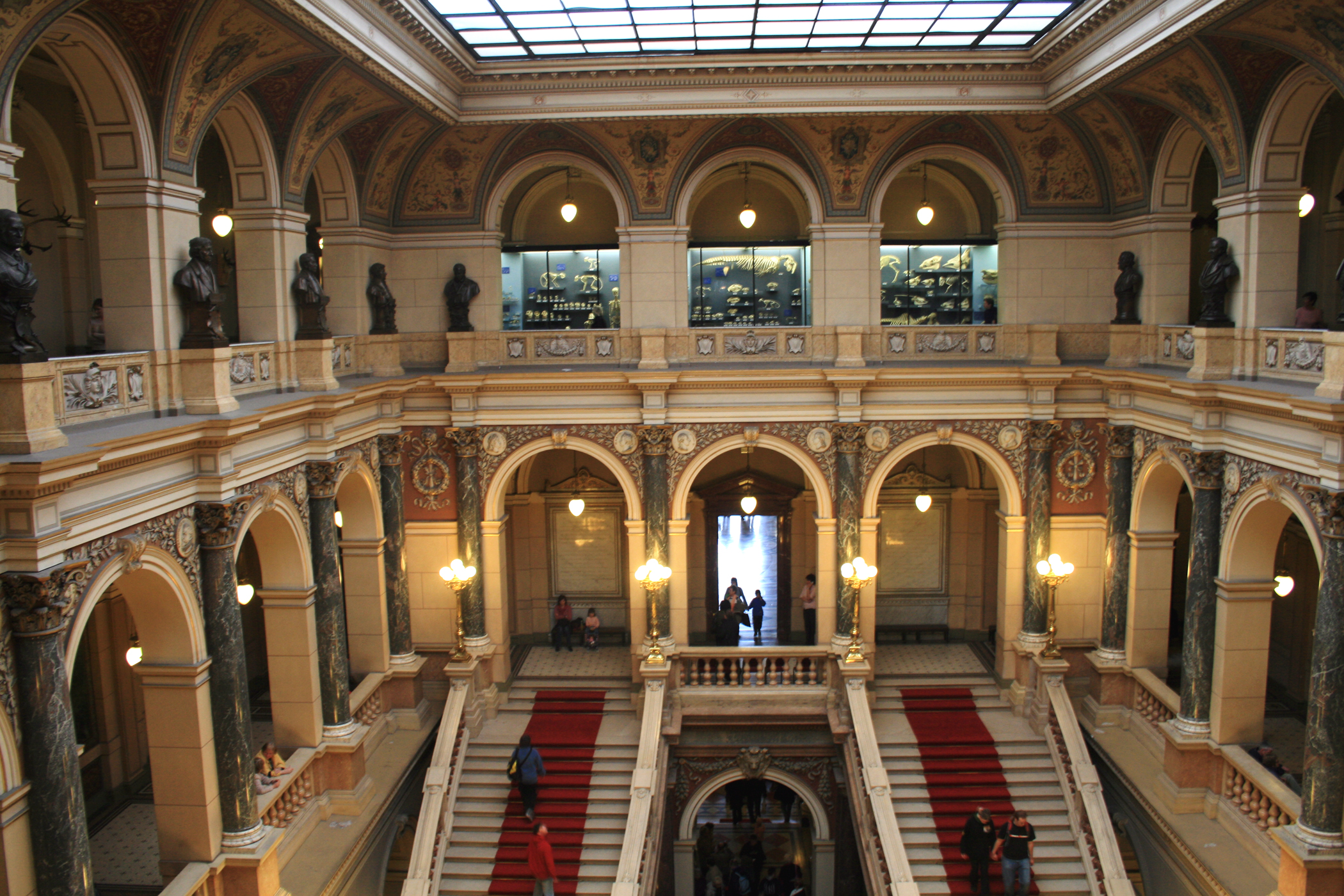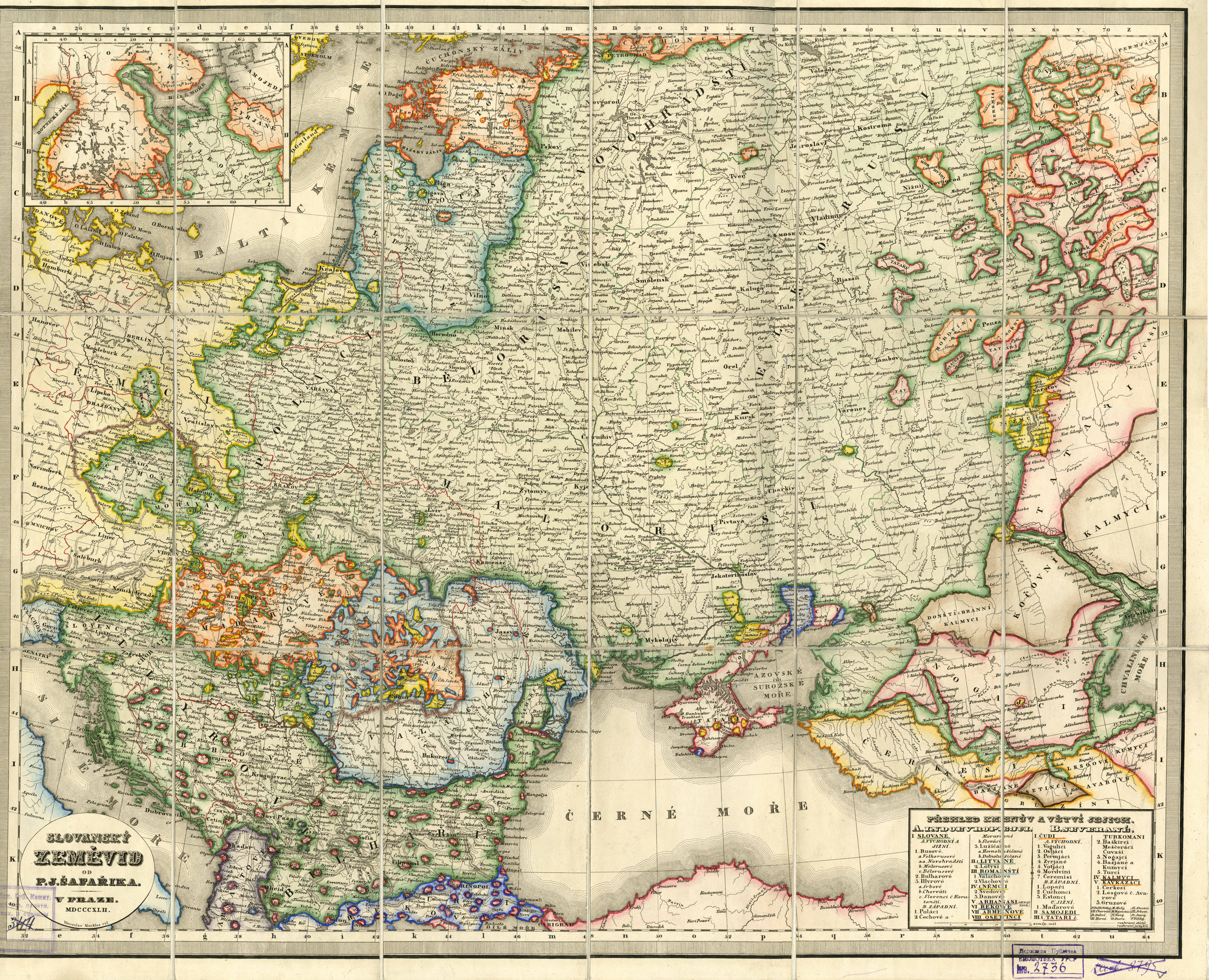|
František Palacký
František Palacký (; 14 June 1798 – 26 May 1876) was a Czech historian and politician. He was the most influential person of the Czech National Revival, called "Father of the Nation". Life František Palacký was born on 14 June 1798, at Hodslavice house 108, a northeastern Moravian village now part of the Moravian-Silesian Region of the Czech Republic. His ancestors had been members of the community of the Bohemian Brethren, and had clandestinely maintained their Protestant belief throughout the period of religious persecution, eventually giving their adherence to the Augsburg confession as approximate to their original faith. Palacký's father was a schoolmaster and a man of some learning. The son was sent in 1812 to the Evangelic Lutheran Lyceum at the then- Hungarian city of Bratislava, where he came in contact with the philologist Pavel J. Šafařík and became a zealous student of Slavic languages (he mastered 11 languages and became familiar with a few others). ... [...More Info...] [...Related Items...] OR: [Wikipedia] [Google] [Baidu] |
Jan Vilímek
Jan Vilímek (; 1 January 1860 – 15 April 1938) was a illustrator and Painting, painter from Boehmia who eventually became a Czechoslovak national. Vilímek was born on 1 January 1860 in Žamberk, Bohemia, Austrian Empire. He created many portraits of famous personalities from Bohemia and other Slavs, Slavic nations. During the 1880s, these portraits were regularly published in magazines such as ''Humoristické listy'', ''Zlatá Praha'' and ''Světozor''. In the 1890s, some of these illustrations were assembled into a book, ''České album''. He died on 15 April 1938 in Vienna. Jan Vilímek - Bedřich Smetana.jpg, Bedřich Smetana Jan Neruda – Jan Vilímek – České album.jpg, Jan Neruda Jan Vilímek - Ignacy Jan Paderewski.jpg, Ignacy Jan Paderewski File:Jan Vilímek - Antonín Dvořák.jpg, Antonín Dvořák External links * :cs:Seznam portrétů Jana Vilímka, List of Vilímek's portraits on Czech Wikipedia (incomplete, sorted by source, with links to digitized ... [...More Info...] [...Related Items...] OR: [Wikipedia] [Google] [Baidu] |
Augsburg Confession
The Augsburg Confession (), also known as the Augustan Confession or the Augustana from its Latin name, ''Confessio Augustana'', is the primary confession of faith of the Lutheranism, Lutheran Church and one of the most important documents of the Protestant Reformation. The Augsburg Confession was written in both Early New High German, German and Ecclesiastical Latin, Latin and was presented by a number of German Imperial State, rulers and free-cities at the Diet of Augsburg on 25 June 1530. The Holy Roman Emperor, Charles V, Holy Roman Emperor, Charles V, had called on the Princes and Free Territories in Holy Roman Empire, Germany to explain their religious convictions in an attempt to restore religious and political unity in the Holy Roman Empire and rally support against the Ottoman wars in Europe, Ottoman invasion in the 16th-century Siege of Vienna (1529), Siege of Vienna. It is the fourth document contained in the Lutheran ''Book of Concord''. Background Philipp Melanch ... [...More Info...] [...Related Items...] OR: [Wikipedia] [Google] [Baidu] |
Konstantin Von Höfler
Konstantin von Höfler was a German church and general historian, publicist, ennobled anti-nationalist politician and poet. Biography and works He was born at Memmingen in Bavaria (southern Germany) on 26 March 1811; died at Prague, 29 December 1898. After finishing his studies in the gymnasia at Munich and Landshut, he studied first jurisprudence and then history at the University of Munich under Guido Görres, Ignaz von Döllinger and especially Friedrich Wilhelm Joseph Schelling, and received his degree in 1831 on presenting the dissertation "Ueber die Anfänge der griechischen Geschichte" bout the Beginnings of Greek History Aided by a pension from the government, he studied two more years at Göttingen, where he published a "Geschichte der englischen Civilliste" istory of the English Civil List He then went to Italy, residing chiefly at Florence and Rome, and worked there industriously in the examination of original sources. Returning to Munich he accepted the editorshi ... [...More Info...] [...Related Items...] OR: [Wikipedia] [Google] [Baidu] |
Catholic
The Catholic Church (), also known as the Roman Catholic Church, is the List of Christian denominations by number of members, largest Christian church, with 1.27 to 1.41 billion baptized Catholics Catholic Church by country, worldwide as of 2025. It is among the world's oldest and largest international institutions and has played a prominent role in the history and development of Western civilization.Gerald O'Collins, O'Collins, p. v (preface). The church consists of 24 Catholic particular churches and liturgical rites#Churches, ''sui iuris'' (autonomous) churches, including the Latin Church and 23 Eastern Catholic Churches, which comprise almost 3,500 dioceses and Eparchy, eparchies List of Catholic dioceses (structured view), around the world, each overseen by one or more Bishops in the Catholic Church, bishops. The pope, who is the bishop of Rome, is the Papal supremacy, chief pastor of the church. The core beliefs of Catholicism are found in the Nicene Creed. The ... [...More Info...] [...Related Items...] OR: [Wikipedia] [Google] [Baidu] |
Hussite
file:Hussitenkriege.tif, upright=1.2, Battle between Hussites (left) and Crusades#Campaigns against heretics and schismatics, Catholic crusaders in the 15th century file:The Bohemian Realm during the Hussite Wars.png, upright=1.2, The Lands of the Bohemian Crown during the Hussite Wars. The movement began during the Renaissance in Prague and quickly spread south and then through the rest of the Kingdom of Bohemia. Eventually, it expanded into the remaining domains of the Bohemian Crown as well. The Hussites (Czech language, Czech: ''Husité'' or ''Kališníci'', "Chalice People"; Latin: ''Hussitae'') were a Czech Proto-Protestantism, proto-Protestant Christian movement influenced by both the Byzantine Rite and John Wycliffe that followed the teachings of reformer Jan Hus (floruit, fl. 1401–1415), a part of the Bohemian Reformation. The Czech lands had originally been Christianized by Byzantine Empire, Byzantine Greek missionaries Saints Cyril and Methodius, who introduced the ... [...More Info...] [...Related Items...] OR: [Wikipedia] [Google] [Baidu] |
National Museum (Prague)
The National Museum (NM) (Czech language, Czech: ''Národní muzeum'') is a public museum dedicated to natural scientific and historical collections of the Czech Republic, its History of the Czech lands, history, Culture of the Czech Republic, culture and Czechs, people, among others. The museum was founded in 1818 by Kaspar Maria von Sternberg, Kašpar Maria Šternberg. Historian František Palacký was also strongly involved in the foundation of the museum. The National Museum houses nearly 14 million items from the areas of natural history, history, arts, music and librarianship, which are located in dozens of museum buildings. The main hall of the National Museum is located on Wenceslas Square in downtown Prague. Built in Renaissance Revival architecture, neo-renaissance style in 1891, the building underwent significant restoration from 2011 to 2018 to mark the centennial of the Czechoslovak declaration of independence, Czech and Czechoslovak declaration of independence. Due ... [...More Info...] [...Related Items...] OR: [Wikipedia] [Google] [Baidu] |
Josef Dobrovský
Josef Dobrovský (17 August 1753 – 6 January 1829) was a Czech philologist and historian, one of the most important figures of the Czech National Revival along with Josef Jungmann. Life and work Dobrovský was born at Balassagyarmat, Nógrád County, in the Kingdom of Hungary, when his father Jakub Doubravský (1701, Solnice – 1764, Horšovský Týn) was temporarily stationed as a soldier there. His mother was Magdalena Dobrovská (1733, Čáslav – 1797). He received his first education in the German school at Horšovský Týn, made his first acquaintance with the Czech language and soon made himself fluent in it at the Německý Brod gymnasium, and then studied for some time under the Jesuits at Klatovy. In 1769 he began to study philosophy at the University of Prague. In 1772 he was admitted among the Jesuits at Brno and was preparing for a Christian mission in India. However, the entire order was dissolved in the Czech lands in 1773 and Dobrovský thus retu ... [...More Info...] [...Related Items...] OR: [Wikipedia] [Google] [Baidu] |
Slavic Languages
The Slavic languages, also known as the Slavonic languages, are Indo-European languages spoken primarily by the Slavs, Slavic peoples and their descendants. They are thought to descend from a proto-language called Proto-Slavic language, Proto-Slavic, spoken during the Early Middle Ages, which in turn is thought to have descended from the earlier Proto-Balto-Slavic language, linking the Slavic languages to the Baltic languages in a Balto-Slavic languages, Balto-Slavic group within the Indo-European family. The current geographical distribution of natively spoken Slavic languages includes the Balkans, Central and Eastern Europe, and all the way from Western Siberia to the Russian Far East. Furthermore, the diasporas of many Slavic peoples have established isolated minorities of speakers of their languages all over the world. The number of speakers of all Slavic languages together was estimated to be 315 million at the turn of the twenty-first century. It is the largest and most d ... [...More Info...] [...Related Items...] OR: [Wikipedia] [Google] [Baidu] |
Pavel Jozef Šafárik
Pavel Jozef Šafárik (; 13 May 1795 – 26 June 1861) was a Slovak philologist, poet, literary historian, historian and ethnographer in the Kingdom of Hungary. He was one of the first scientific Slavists. Family His father Pavol Šafárik (1761–1831) was a Protestant clergyman in Kobeliarovo and before that a teacher in Štítnik, where he was also born. His mother, Katarína Káresová (1764–1812) was born in a poor lower gentry family in Hanková and had several jobs in order to help the family in the poor region of Kobeliarovo. P.J. Šafárik had two elder brothers and one elder sister. One brother, Pavol Jozef as well, died before Šafárik was born. In 1813, after Katarína's death, Šafárik's father married the widow Rozália Drábová, although Šafárik and his brothers and sister were against this marriage. The local teacher provided Šafárik with Czech books. On 17 June 1822, when he was in Novi Sad (see below), P. J. Šafárik married 19-year-old Júlia Ambr ... [...More Info...] [...Related Items...] OR: [Wikipedia] [Google] [Baidu] |
Philologist
Philology () is the study of language in oral and written historical sources. It is the intersection of textual criticism, literary criticism, history, and linguistics with strong ties to etymology. Philology is also defined as the study of literary texts and oral and written records, the establishment of their authenticity and their original form, and the determination of their meaning. A person who pursues this kind of study is known as a philologist. In older usage, especially British, philology is more general, covering comparative and historical linguistics. Classical philology studies classical languages. Classical philology principally originated from the Library of Pergamum and the Library of Alexandria around the fourth century BC, continued by Greeks and Romans throughout the Roman and Byzantine Empire. It was eventually resumed by European scholars of the Renaissance, where it was soon joined by philologies of other European ( Romance, Germanic, Celtic, ... [...More Info...] [...Related Items...] OR: [Wikipedia] [Google] [Baidu] |






